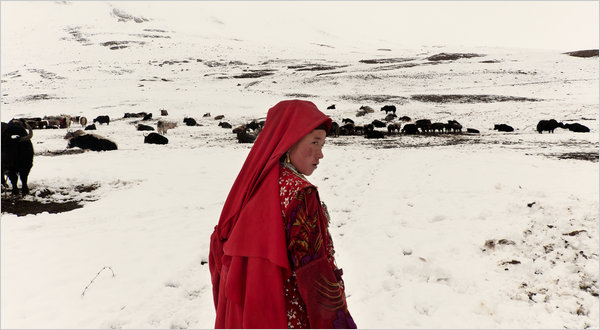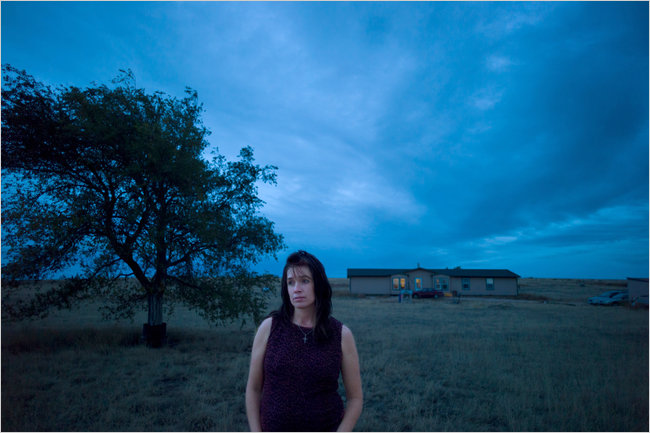A recent New York Times story featured this photograph of a woman walking toward a yak herd in northern Afghanistan. The photo was taken in August.

She lives in the Wakhan Corridor, a region beyond the Hindu Kush mountain range that has been remote enough to usually escape the ravages of war. It doesn’t seem hard to see why. Sans oil or accessible mineral deposits, the combination of geography and climate should suffice to maintain relative isolation. That was the point of the story and certainly of the photograph: some modernization is underway, but the people there are likely to continue to live largely as they have, that is, in pastoral cultures bound by the simple routines and set traditions that equip them to survive in a harsh natural environment.
The woman in the photograph exemplifies this portrait. She is layered in the colorful clothing assumed to be the mark of ethnic authenticity, and if she looks apprehensive, it has more to do with the intrusion of the photographer than any hesitation regarding the challenges of separating her yak from the herd spread across the frozen landscape. She trudges out into the cold dutifully, as she really has little choice: the yak has to be milked, and her family needs the milk, and what else is there to do anyway? This is not her world from the inside, of course, but the image draws on a long history of travel photography carrying these assumptions. The bottom line is that she may be doing well enough–look closely at her clothing, for example–but that few readers of the Times would want to change places with her. Yak milk in a yurt on a frozen plateau is one thing, and a latte in an urban coffee shop is quite another.

If those were the only two options, the world might be a pretty good place. But there can be worse environments than those created by the weather. The market economy, for example, particularly when people have to depend, not on their animals, but on predatory mortgage companies. This woman was featured in another Times story on the same day. She is standing before her house in Colorado. This could be a picture of the American Dream: a single women can own her own house, complete with a terrific view of the Western sky. You can sense that’s not the case, however, as her rueful expression is reinforced by the dark tonality of land and clouds. The weather is warm enough that she can be sleeveless, but the scene nonetheless feels cold and ominous.
And rightly so: she is having to defend herself against foreclosure by Deutsche Bank, which, after a mortgage company changed her locks without cause and then encouraged her to skip a payment while restitution was arranged, has moved to seize the house on grounds of non-payment. Having done nothing wrong, she now is having to incur legal fees just to hold on to the home and the equity that was rightfully hers. And I’ll bet that her sense of security and social trust is not doing so well, either. Maybe having your own yurt wouldn’t be so bad after all.
Photographs by Gilles Sabrie and Kevin Moloney for The New York Times.
I love the connection made between these two women. Both are from very different places, and live very different lives, but the look in each of their eyes is the same. While one is escaping the ravishes of war in her county, the other is fighting a war. Though the meaning of war differs in each situation, both women are still strong, and both women are still fighters.
I keep finding myself going back and looking at these for they catch your eye. The concept of gaze through these pictures, especially the first one really grabs my attention. The idea that the entire background is a bright white and then she is placed front and center wearing bright red and just turned to stare with a look of desperation almost. In both pictures the scenes feel cold and dark neither feel or give off any type of happy ambiance. You would never know what these women have been through but you can tell both have a lot of misery in their eyes. The second picture is interesting for you come to find out the only thing she probably has is her house behind her, which would be ideal. But not when you find out that that’s the issue and that the bank of foreclosing her possession on her then you see her standing there in the middle of the picture in a dark setting but tank top almost with bitterness.
Both these images really caught my attention more than the other pictures from this blog. The colors from the first image were so dramatic and had such a complete contrast, which made me more intrigued to understand what the meaning was behind the photo. Both these images display isolation, in that they both seem lonely in the atmosphere they are in. Before reading the captions of both images, I could immediately tell that the girl in red looked like she was traveling or moving somewhere to get away from where she is from and the woman on the bottom picture looked as if she was trapped where she was and wanted to find a way to get out but was simply stuck there. Even though both these images are with completely different types of women with different stories, they are both representing loneliness in a dark or cold environment. Both women do not look happy, and as a viewer it makes me want to read more about the images and disacover the true meaning behind each woman.
Both of these images really caught my attention because they both were images of women. Each image used had bold colors and had the focus around each woman. Although, the story behind each photograph is what is most important me. Each photograph told a similar story but in two different cultures and locations. By my first glance I saw two isolated, drained women in two different locations. Each seemed to have had struggles to some extent through their life and continuing through this photo. One woman is physically living in war conditions and the other fighting her own war to save her home. They both look as if they wish they had better but they accept what they have. As a female viewer it brakes by heart and makes me appreciate the people and things that I have been gifted with!
Both the photographs are filled with culture and struggles within them. Their struggles as women and the demands of duty to be called, such as feeding the children, achieving what needs to be done. Even though the two women are on two different sides of the earth they do have that in common and both are in rual areas(by looking at photographs). In the articles it points out what issues the woman face, the woman in snow has to milk the Yak and the other woman is fighting against foreclosure. Overall great photographs.